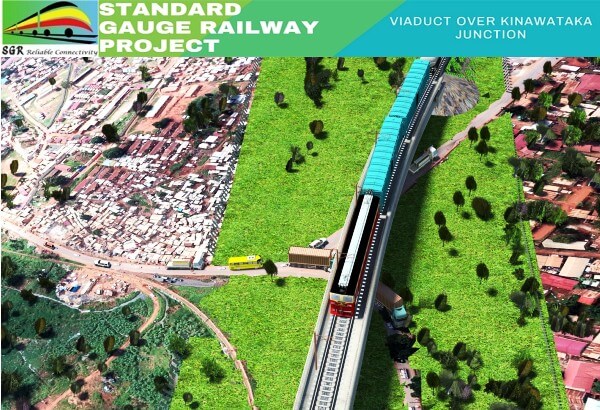
Our Projects are
Transforming African Trade
Quick Contacts
2nd Floor, Fidelity Insurance Centre Waiyaki Way, Westlands

The East African Community (EAC) secretariat has mobilised almost $1bn to finance infrastructure projects in the region.
While regional governments present these development schemes as a result of their own mobilisation, ChimpReports understands the better part of sourcing for funds is done by the EAC secretariat.
Infrastructure is considered one of the most critical enablers of a successful regional integration, taking into account its importance in facilitating activities such as trade, agriculture, tourism and the movement of labour and other resources.
According to a report recently submitted to East Africa Legislative Assembly by the Secretariat, the Africa Development Bank (AfDB) Board has approved financing for several projects in Uganda, Rwanda, Burundi, South Sudan, Kenya and Tanzania.
The bank, through EAC, approved $349m for the construction of the multinational Nyakanazi – Kasulu – Manyovu road in Tanzania (301 km) and Rumonge – Rutunga – Bujumbura road in Burundi (78 km).
Through the NEPAD-IPPF Special Fund, AfDB has provided a grant to the EAC for the feasibility study of the multinational Masaka – Mutukula road in Uganda (89 km) and the Mutukula – Kyaka (30km) / Bugene – Kasulo road in Tanzania (124 km).
Still in Uganda, AfDB, through EAC, approved USD229m to finance part of the cost of Kampala-Jinja Expressway on the Northern Corridor, with the rest being mobilized through a PPP arrangement.
This road is expected to reduce the traffic congestion along Jinja highway to the border with Kenya, a major transit point for imports and exports.
Currently, the Isaka-Kigali Standards Gauge Rail (SGR) Network Project (Tanzania-Rwanda) is being reviewed and updated by AfDB.
Rwandan President Paul Kagame recently revealed that efforts were underway to agree on a financing model for the ambitious project.
Rwanda is expected to sink in US$1.2 billion while Tanzania will part with 1.3billion for the delayed joint railway project.
EAC Secretary General Liberat Mfumukeko recently told businessmen in Kenya that a special fund was being created by the Secretariat to strengthen capacity of the local private sector to undertake key infrastructural projects in the region and boost Small and Medium-sized Enterprises.
“Working with the Governments, African Development Bank, the World Bank, the European Union, and the Private Sector, we are designing an EAC African Development Fund to contribute to meeting this infrastructure gap, including through the mobilization of domestic resources,” said Mfumukeko.
The raising of funds for these projects comes at a time the region is grappling with infrastructural bottlenecks often caused by inadequate and aging infrastructure. This continues to significantly impact the cost of trade in the region.
Projects
ChimpReports understands that through EAC, AfDB is funding a feasibility study for the trans boundary fecal sludge management among urban poor populations of Uganda, Tanzania and Kenya around Lake Victoria.
The Bank has earmarked a grant USD1.65m from the African Water Facility for the project.
The EAC trade development programme which includes NTBs, simplified trade regime, operationalization of tripartite is also being considered by AfDB.
According to the EAC Trade and Investment Report 2017, Total EAC trade in 2017 grew by 8.6% to US$ 46.9 billion on account of increased imports and falling exports.
However, imports into the region grew by 19.5% to US$ 32.2 billion in 2017 while exports fell for a second consecutive year.
Exports from EAC in 2017 fell by 9.3% to USD 14.7 billion. On the other hand, intra-EAC trade grew in 2017, whereby intra-regional imports grew by 14.1% to US$ 2.5 billion while intra-regional exports grew by 8.1% to US$ 2.9 billion in 2017.
Nevertheless, intra-EAC imports and exports accounted for only 7.7% and 18.7% of total imports and exports respectively, signaling that intra-regional trade constituted a small proportion of total EAC trade in 2017.
President Museveni recently urged the region to resolve existing strategic bottlenecks if the EAC is to spur integration and to enable citizens enjoy the accrued benefits. He said such a move would see the region move from economic integration to political integration.
Over the past decade, East Africa has been the fastest-growing region in Africa and is home to several of the fastest-growing economies in the world.
Since the EAC’s establishment in 2000, the organization has implemented rapid institutional change that has turned the EAC into one of the continent’s most dynamic trade blocks.
The organization has been a key driver of East African infrastructure development and has gradually reduced tariffs, trade barriers, and bottlenecks in the region, helping members increase their trade performance.
Originally founded by Kenya, Uganda, and Tanzania, the EAC now includes Rwanda, Burundi, and South Sudan. Although Ethiopia is not a member, the country collaborates closely with the EAC on infrastructure projects and has signed several agreements to boost its trade with the EAC.
Source: Chimp Reports
Disclaimer: The views and opinions expressed in this article are those of the authors and do not necessarily reflect the official policy or position of TradeMark Africa.